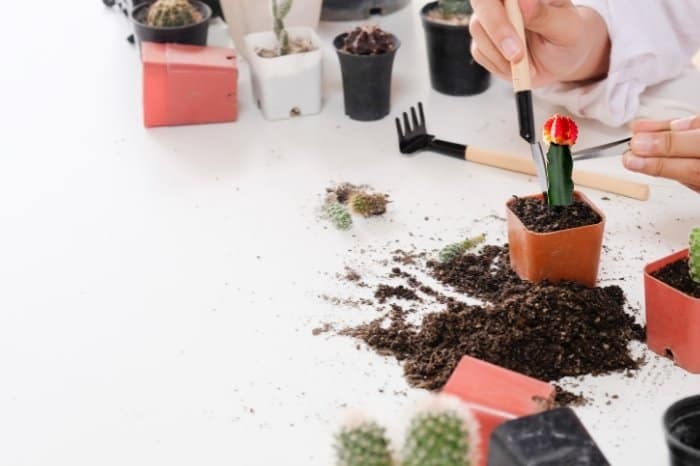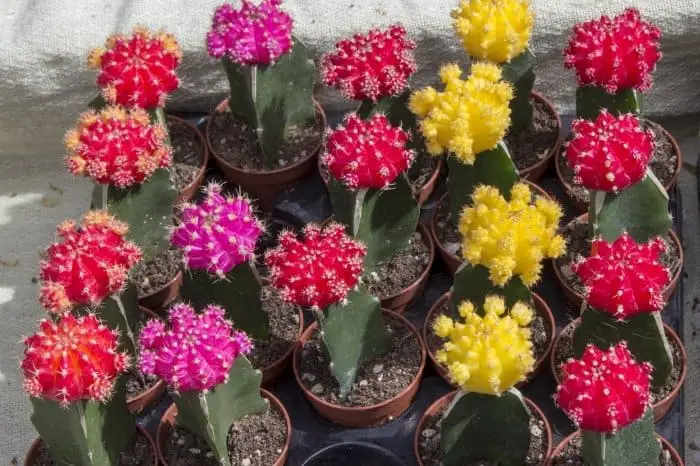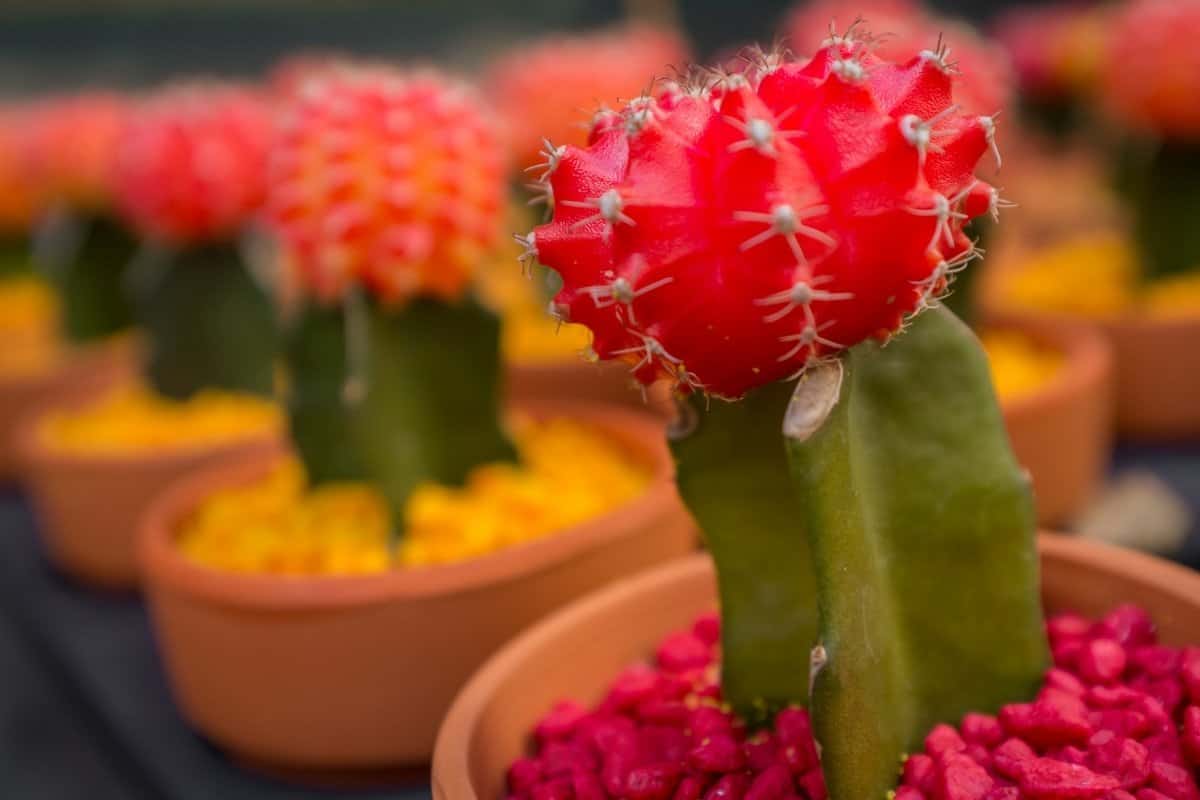Last Updated on October 15, 2021 by Cristina
This article will address how to take care of a moon cactus from planting to achieve that stunning houseplant you always wanted.
The moon cactus plant (Gymnocalycium mihanovichii) is native to South America’s deserts in Argentina, Brazil, and Paraguay.
It is a member of the Cactaceae family popularly known as a red cap, ruby ball cactus, and star flowered cactus. The moon cactus measures approximately 1 to 2 inches wide and has clusters of small, sharp spines when fully grown.
When grown as houseplants, these moon cacti are typically mutants; they do not produce chlorophyll. This is the reason why they have such vivid colors —from hot pink to neon yellow.
Due to the lack of chlorophyll, these plants must be grafted on a cactus rootstock to survive. The moon cactus is commonly grafted with dragon fruit (Hylocereus undatus), but it can be combined with a green cactus of any species; Trichocereus spachianus or Cereus peruvianus.
How To Propagate Moon Cactus
This colorful plant is easy to cultivate using the little offshoots it produces. Please note that not all moon cactuses grow offshoots.
These offshoots can be grafted onto another rootstock or cactus-like the Cereus peruvianus, Hylocereus trigonus, or Trichocereus spachianus. To propagate your cactus, follow the following steps.
- Use a clean knife to cut off the top piece that you want to plant.
- Get a healthy cactus, cut off the top so that it’s only a few inches tall. Set the offshoot you want to plant on top of your new rootstock. Let it sit comfortably on the part that you cut.

- Hold them together with a string or rubber band vertically, wrapping it around your plant and pot to keep everything in place.
- Within 6 to 8 weeks, your plants should be growing together as one! Just be sure to keep an eye for any pests or rot at the time.
- When cutting off your shoots and your rootstock, ensure you use a clean knife to prevent infections to the new plant. When you hold them together, use a rubber band to keep them firmly together. Allow at least 2 months for them to be fully conjoined before removing the rubber band.
How To Care For A Moon Cactus
Moon cactus care is ideal to ensure the succulents bloom with vibrant flowers in late spring or early summer.
Provide Adequate Sunlight
For your cactus moon to last, you will need to keep them indoors, whether in a greenhouse or near a bright window. If you plant it outdoors, you will need to protect it from the sun.
You can keep it under morning or afternoon sun for at least 1 or 2 hours each day, depending on where you live. If you live where the sunlight gets super intense, you will need to shield your plant from sunburn. You will know your plant is sunburned if it’s showing beige patches on its skin.
Moon cactus does not thrive in the cold; it needs to be kept in a relatively warm place protected from frost. Providing it with the right amounts of sunlight and water will cause it to thrive!
Please note that a cactus requires adequate sunlight but not too much. It can be tricky to determine how much is too much or how much is too little. However, you must find the balance by providing your plant with 1 to 2 hours of morning or afternoon light, whether growing near a window or in a shady area.
Provide It With Enough Water
Where the plant requires a good amount of sun, it means watering must happen. Like most succulents and cactus plants, these plants do not require too much watering. Water them for about 2 weeks allowing the soil to dry in between each watering schedule.
During winter, your moon cactus will need watering less frequently, especially if it’s over a year old. Use a pot that has ample drainage holes to prevent root rot from moisture buildup.
Use Well-Draining Soil
Your moon cactus will do well in well-draining soils. Succulents are grown even in poor soils, but this indoor plant doesn’t use poor soils. Your potting mix must be light and airy to allow water to drain well without keeping it stagnant.
Hoffman 10404 Organic Cactus and Succulent Soil Mix, 4 Quarts, Brown/A
Your pot must also have enough drainage holes to allow the water to flow out. Add coarse sand or perlite to your potting mix to improve its drainage. If the soil holds the water for too long, the roots suffer from root rot or mealybugs.
Common Moon Cactus Problems
Pests. When you newly propagate your noon cactus, it is common to see bugs eating your freshly cut cactus. Use neem oil spray to keep these pests away and do it early enough to notice the infestation.
Beige Spots. Moon cactus is quite sensitive to too much sunlight. It will develop beige patches when sunburned. If this happens to your cactus plants, move them to a space that has less sunlight to heal. Provide them with adequate water to help them recover fast from sunburn damage.
Root Rot. Too much watering kills this plant’s root. These plants are highly susceptible to root rot if you overwater them. If you notice the lower part of the stem softens, it’s highly likely due to rot. You might be able to salvage the plant by cutting above the squishy part and re-planting it as a cutting. However, its survival rate is low.

Conclusion
Moon cactus is gorgeous to add to your plant collection if you have not already done so. It is relatively easy to care for, but because of their short life spans and lack of chlorophyll, they can cause you heartbreak.
Nevertheless, these plants make a fun addition to your succulent collection. If you are looking for a pop of color, minimal watering requirements, and a unique mutant plant might be the perfect gift to you.
Now go ahead and take good care of your moon cactus. Grow as many as you can and enjoy the pop of color they give you each blooming season.
Caroline is a gardener who loves to get down to the nitty–gritty of gardening. She proudly proclaims herself as a ‘dirt worshipper‘ and can often be found deep in the garden, covered in soil and singing to her plants. As a self–proclaimed ‘plant whisperer‘, Caroline believes that plants need love and attention just like any other living thing, and she loves to give them both. When she‘s not tending to her garden, you can often find her researching the latest gardening trends, or teaching others how to make their gardens thrive


